Contents
The bee trap helps the beekeeper catch roaming swarms. Due to a simple adaptation, the beekeeper expands his farm with new bee colonies. It is easy to make a trap, it is more difficult to find a suitable place for it and pile it up on a tree.
What are bee traps used for in beekeeping?
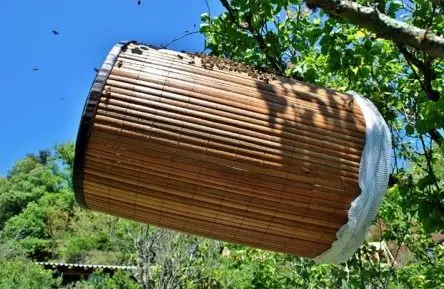
Any trap design is created with only one purpose – to catch a swarm of bees wandering through the forest. Swarming brings benefits and harms. It all depends on how quickly the beekeeper reacts. If time is lost, the bees and their queen will leave the hive in search of a new home. For the beekeeper, this is a loss. Another beekeeper benefits. By setting traps, he will be able to capture the swarm and place it in his hive.
What does a bee trap look like?
The appearance of the trap resembles an ordinary container. It can be of any shape: square, oval, rectangular and others. The material for the manufacture is usually wood or plastic. You can adapt a factory container, such as a plastic barrel, for a trap. An important element is the inlet and the presence of a damper. When a swarm of bees flies into a trap, it does not get back. Insects settle on the bait located inside the container. It remains for the beekeeper to close the damper and transfer the swarm to his hive.
The use of swarms in beekeeping
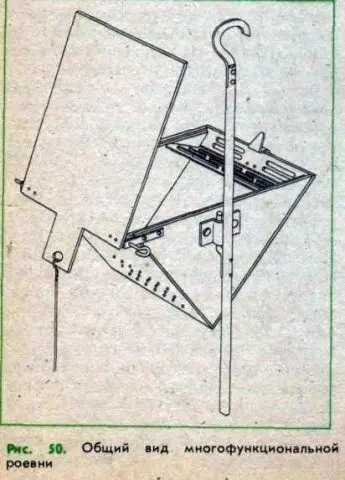
In fact, the swarm is an analogue of a trap, but has differences in design. In addition, the device is multifunctional. If a trap can only catch a wandering swarm, then swarms perform the following operations:
- swarm prevents the swarm from flying out of the hive during the absence of the beekeeper in the apiary;
- swarms remove a swarm from a tree, accumulated in a ball;
- swarm serves as a temporary storage of bees in a cool room;
- Drones are caught with swarms, the queen is separated from the swarm, and the queen of the hatched family is detained inside the hive.
Experienced beekeepers use swarms for other operations that would require at least three apiary devices.
How to make a bee trap with your own hands
To create a trap, you will need to find or make a container. When choosing a shape and model, it is optimal to give preference to a vertical type design. When the trap looks more like a hollow, the bees will master it faster.
Dimensions and drawings of the bee trap
Do-it-yourself special drawings for bee traps are not needed. The device consists of a container with an inlet and a damper. As a valve, a piece of fiberboard or plywood is suitable, blocking the entrance in size. Beekeepers come up with different ways to fix the damper. Usually it rotates on a hairpin or loops. For clamping, they put a spring, adjust the lever handle.
It is more important to calculate the size correctly. The optimal volume of the trap for catching a large swarm is 40 liters. A container with a smaller volume will be able to catch a small swarm of bees. It is unreasonable to increase the volume of the trap more than 60 liters. The number of bees will not increase, and it is difficult to pile it on a tree. In addition, material consumption increases.
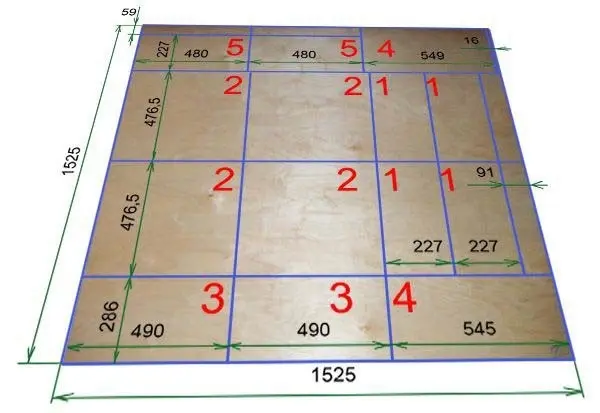
You can cut the trap out of plywood or fiberboard. One of the covers is provided for opening for laying bait.

Even an ordinary plastic bottle can act as a trap. Small containers for catching swarms will not work. Traps can only catch pests. To catch a large swarm, you will need a bottle of the appropriate volume, and you can take it from the water cooler.
Tools and materials
Depending on what kind of trap is supposed to be made for bees, the tool and material are selected.
To assemble a plywood trap, you need:
- plywood, slats with a section of 20×20 mm, non-wetting material for the roof, sheet foam;
- nails, hammer, pliers, jigsaw.
To assemble a plastic trap, you need:
- a large bottle from a water cooler;
- wire, adhesive tape;
- scissors, knife, awl.
Be sure to any trap will need paint to paint the body.
Assembly process
A plywood trap for a bee swarm begins to be made from cutting a sheet. Fragments are more convenient to cut with a jigsaw. The assembly of plywood blanks into boxes is carried out by joining at the corners with battens and nails. All joints are tight. For the inlet on the front panel, a slot is cut in the form of a notch with a size of 100×10 mm. A valve is fitted from the plank.
The top panel will act as a roof. In terms of dimensions, it is larger than the box. Fixation is carried out with loops. The bait is loaded through the roof that opens to the side. From the inside, the walls of the trap are insulated with foam. Outside the boxes are painted, attach handles or a carrying strap. The roof and bottom are impregnated with drying oil, upholstered with non-wetting material.
A primitive bottle trap is made in 10-15 minutes. First, cut off the neck with a small side part. The bait is placed inside the body. The cut element is turned over, and the neck is inserted into the main container. Holes are pierced at the joints with an awl, sewn with wire. The bottle is painted with water-based paint so that the plastic walls from the solvent do not melt. The finished trap is fixed with tape on the tree.
Do-it-yourself swarm for bees
There are many varieties of swarms. Beekeepers make devices in the form of a cone, pyramid, rectangle. Hinged covers with a long cable are used as mechanization. Having installed such a rod on a pole, it is convenient to shoot a swarm of bees hanging high on a tree.
For beginner beekeepers, it is optimal to stop at a rectangular design. The presented drawings of a swarm for bees with their own hands will help to make a device.
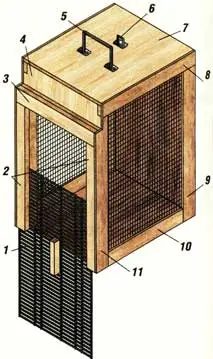
The rod consists of the following parts:
- Latch made of fine mesh. Plexiglas, thin plywood or fiberboard is suitable for the damper.
- Lateral forward racks for movement of a gate valve.
- Front crossbar. The element provides the upper fixation of the valve.
- Plywood walls of the swarm, bottom and ceiling. Two side walls can be made of mesh.
- Handles for carrying and fixing the rod. On the outer side of the bottom there is a latch that holds the valve in an open or closed state.
- A boss measuring 20x35x100 mm is installed on the ceiling from the inside of the swivel, and only the bracket comes out. The boss helps the swarm to gain a foothold.
- Row roof.
- Top planks.
- Back planks.
- Bottom bars.
- Front bars.
Do-it-yourself roevni frame is assembled from the upper, lower, rear and front slats. The optimal design size is 235x280x400 mm. The overall dimensions of the swarm will increase slightly due to the thickness of the plywood sheathing and additional elements.
The connection is carried out with cloves. Joints for reliability are coated with PVA glue or sealant. The mesh is fixed to the frame with slats. A limiting self-tapping screw is screwed on the upper jumper, which helps to fix the valve in the closed state. The finished swarm is dyed and weighed. It is necessary to know the mass to determine the weight of the caught bees.
Pole for catching swarms of bees

When the swarm leaves the hive, the bees circle over the apiary for a while. If you do not miss the moment, they can be caught. The beekeeper makes the simplest device. He attaches an old frame to a long pole and lifts it, trying to direct it into the thick of the swarm. Bees settle on a frame with a pole. It remains for the beekeeper to carefully lower the device, shake off the swarm into the swarm.
How to catch a swarm of bees
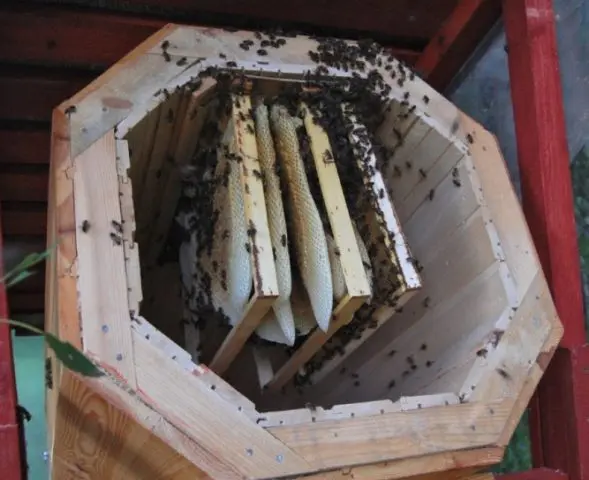
To catch bees in a trap or swarm, you need to know when and where it is better to put them, what to put for bait and many other nuances.
What frames to put in traps for bees
Honeycombs are the best bait for traps. The old foundation of a dark color is optimally suited. The smell of wax attracts bees. If the dimensions of the trap allow, a whole frame is placed inside. Honeycombs are taken only from a healthy bee colony. For disinfection, they are placed in the freezer for 2 days.
When to set traps and swarms for bees
The period of swarming of bees lasts from the last month of spring to mid-July. Not later than May 25, it is necessary to prepare swarms and traps. The swarming process usually ends on July 10th. There is late swarming in September. Usually the period is short. Bees fly in small swarms weighing up to 1,5 kg.
You can learn more about catching bees from the video:
Where is the best place to put traps and swarms for bees
In order for bee colonies to be trapped, you need to know where it is best to place them. Experienced beekeepers have a number of proven rules:
- The optimal height from ground level is 4-6 m. A tall tree is ideal. Bees choose a place away from wet soil and honey thieves.
- The trap must be visible to the bees. If it is difficult for a beekeeper to notice it from 30 m, then the insects will not see it either.
- Set a trap in the shade. Bees will not fly inside a house heated under the sun.
- Trees choose noticeable, and not in the thickets of the forest. Optimal – growing in a large clearing or the outskirts of the road, landing.
- The minimum distance from the apiary is 30-50 m. To catch wild bees, the trap is brought as close as possible to their habitat.
- The chances of catching a swarm of bees in the area of abundantly blooming honey plants increase. There is little food on pastures and coniferous forests, swarms do not appear here.
- Bees cannot live without water. You can catch a family at a distance of 100-200 m from a river, pond, artificial reservoir.
The light color of the trap helps to lure the swarm. It is believed that the inlet should be located to the south. However, experienced beekeepers assure that the direction of the notch is not so important, compared to compliance with proven rules.
How to catch bees in an empty hive

You can catch a swarm not only with a trap or swarm. An empty hive will do the job optimally. The house is suitable only for a single-hull. To lure bees into an empty hive, 6 frames are installed inside. A larger number will take up a lot of space and the swarm will not fit. If there are not enough frames, they will not attract bees.
There is a catching of wandering swarms is very simple. The beekeeper fixes the hive and does not touch it. There is a chance to scare away the bees if the scouts have already visited the house. After settling the family, the hive should not be touched in the same way. Bees must get used to a new home, only then it can be transferred to the apiary.
How to get bees out of a hollow
You can catch wild bees with a swarm or a plywood hive by extracting a nest from a hollow. The procedure is best done in the morning on a clear day. Worker bees at this time fly away for nectar.
To open the hollow and relocate the family, you will need tools and materials:
- ax;
- saw on wood;
- smoker
- buckets;
- swarm or light plywood beehive with frames;
- wooden splinter;
- ladle;
- threads, rope, gauze;
- small plywood sheet.
It is optimal to cut down an old tree with a hollow. The log is laid on the ground opposite the swarm or beehive, mounted on a stand. Letok turn to the hollow. At a level below the notch near the hollow, two cuts are made in 30 cm increments. The wood is split with an ax. For accuracy, more cuts are made and split again in order to expand the hollow to the maximum.
When access to the combs appears, the bees are treated with a smoker. Work is performed in protective masks. A sheet of plywood is laid on a log, a structure of torches and an empty frame is built on top. Honeycombs are cut out inside the hollow, placed in an empty frame, more splinter are placed on top and connected with the lower splinter located under the frame. Cells are securely clamped.
For the resettlement procedure, it is still better to use a hive instead of a swarm. Honeycombs are immediately placed in the house. The smoked bees in the hollow are selected with a scoop, poured into the hive. When the uterus is inside the house, the remnants of the scattered swarm will fly to it on their own. The worker bees will carry the remaining honey from the hollow to the hive. Now you just have to wait for the process to finish. In the evening, the hive with the new family caught is tied with gauze and transferred to the apiary.
How to trap a swarm of wild bees
A swarm of wild bees is of particular value. Insects are hardworking, they winter better. Families are doing well.
To catch wild bees, the same traps or swarms are used. First, find their habitats. The device is tied with a rope to a tree. Place it in the shade. It is optimal to find a fruit tree. A long rope is tied to the flap. When the wild swarm is inside, the valve is closed from the ground by pulling the rope. The principle of catching is the same as for ordinary bees.
How not to miss the swarm from the hive
A flying swarm from the hive brings a loss to the beekeeper. Sometimes beekeepers solve the problem by cutting one wing of the uterus. The queen will not be able to fly out of the hive, and with her the whole family. However, the emerging queen falls to the ground, where it can get lost or die.
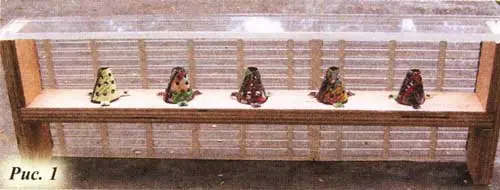
To prevent the swarm from leaving the hive, it is easier to delay the queen herself, to prevent her from leaving the house. A matkolovka is installed on the notch. On fig. 1 device is made in the form of conical caps with holes. The emerging queen will fall into the matkolovka and will not be able to fly away.
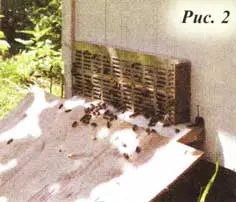
On fig. 2 shows an example of a prefabricated partition grille. It is optimal to use a metal mesh, since the uterus often crawls through the cells of the plastic device.
How to transplant a swarm of bees from a trap or swarm into a hive
A swarm caught in a swarm or trap is left in a cool place. A hive is being prepared for a new family:
- the house is opened for airing and warming under the sun;
- the inner walls of the hive and the canvases are rubbed with freshly picked mint;
- foundation is installed in the hive at the rate of 3 frames per 1 kg of bees;
- additionally, frames with open lower brood are placed, half filled with honey up to about 1,5 kg;
- as an additional food, a feeder with syrup is installed.
Dryness is placed in the nest. For her, a central place is determined, and the sides are taken under the foundation. In the absence of brood frames, they are replaced with combs moistened with mint syrup.
The swarm is transplanted into the hive in the evening in two ways:
- The caught family from the swarm is simply poured into the hive through the open lid. The bees clinging to the walls are shaken off with light blows on the body of the swarm.
- Gangways are made from a sheet of plywood. They are installed between the entrance of the hive and the swarm turned over on one of the sides. The optimal dimensions of the arrival gangways for shaking off swarms are 100×70 cm. The second indicator can be reduced to 50 cm.
Transplantation through the gangway is considered the best. It is easier for the beekeeper to verify the presence of the queen and find it.
Preservation of late caught swarms of bees
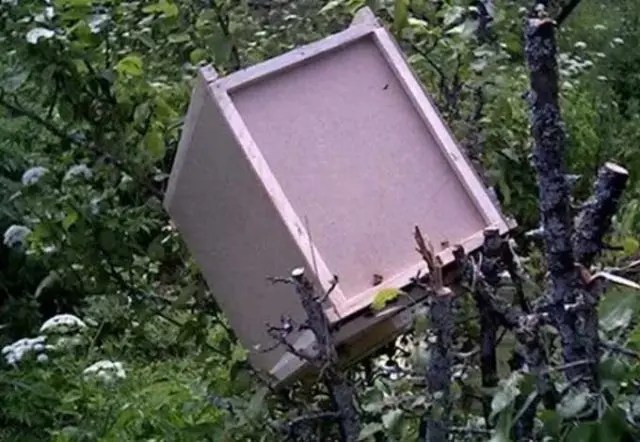
From the end of August there is a chance to catch a late swarm. He is usually small. The captured family is placed in a hive with five frames, where it hibernates. After a successful wintering in 2 years, up to 5 families will be obtained from the late swarm. However, beekeepers note the viciousness of insects as a minus of such capture. The bees sting, preventing them from approaching the apiary within a radius of more than 100 m.
Conclusion
A bee trap will be useful if you know how to use the device. Not a single professional beekeeper can do without a swarm. Inventory is made based on their experience and tips from avid beekeepers.









